2022 메르세데스 AMG SL 43 로드스터 공식 데뷔, 사진 원본들
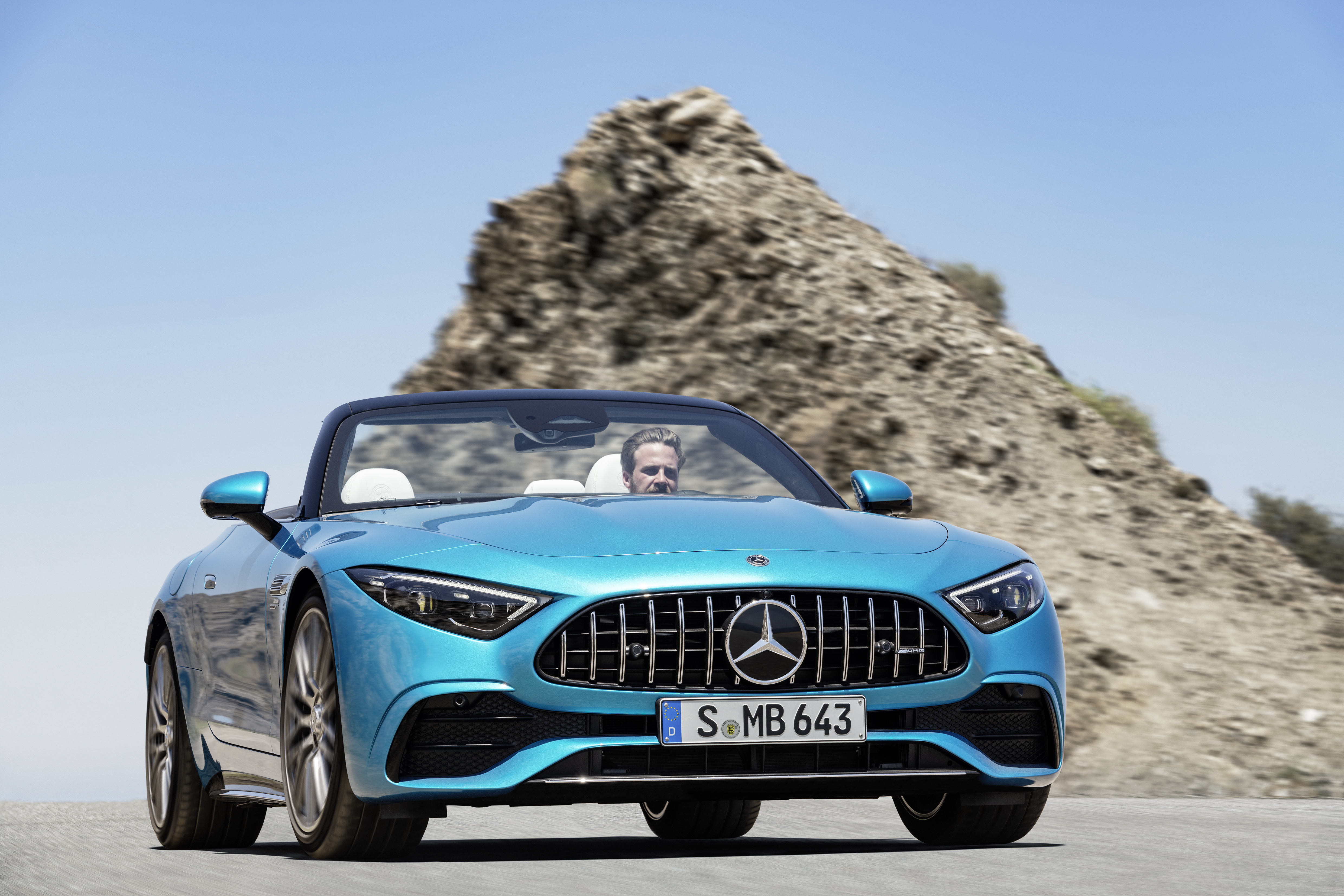




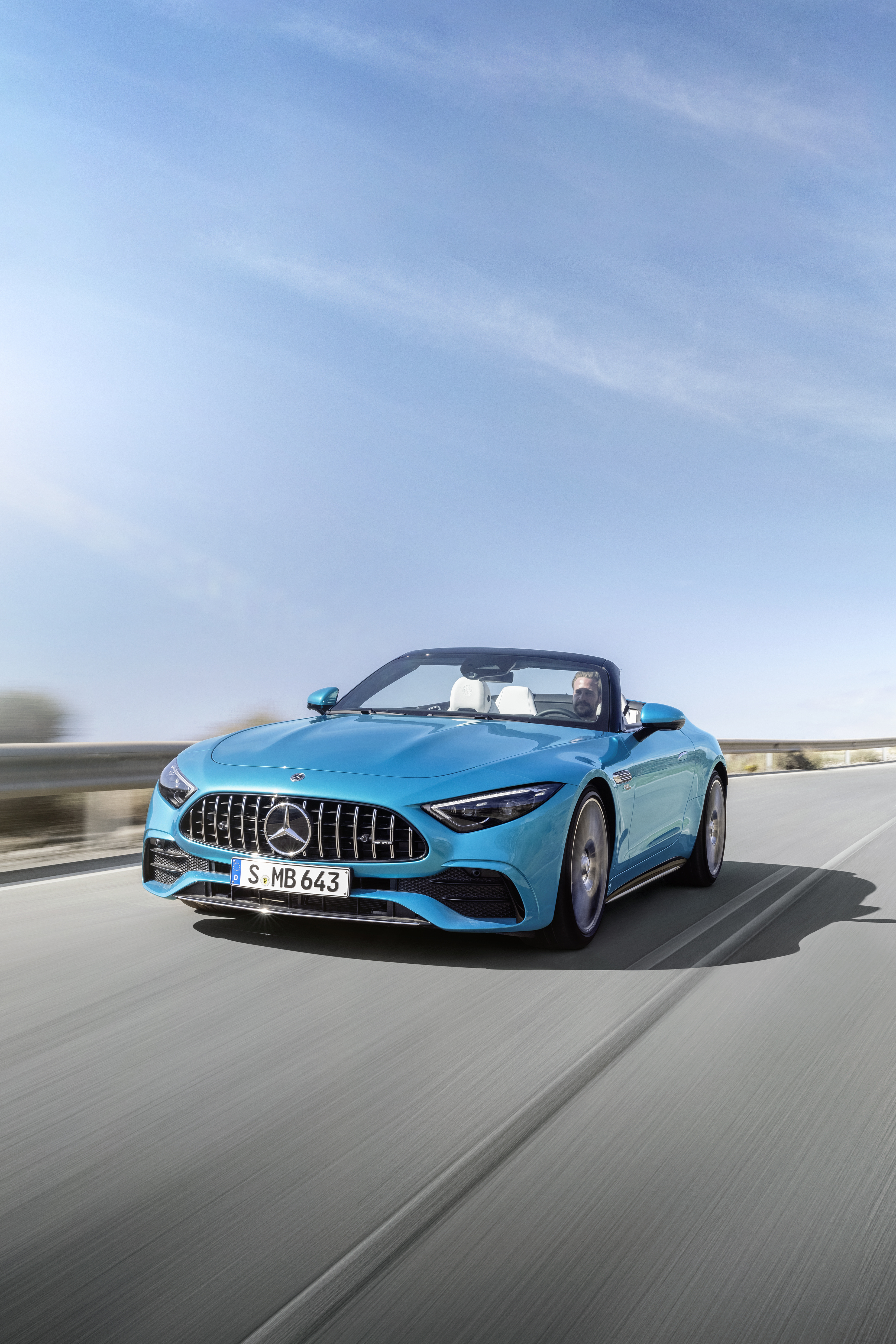









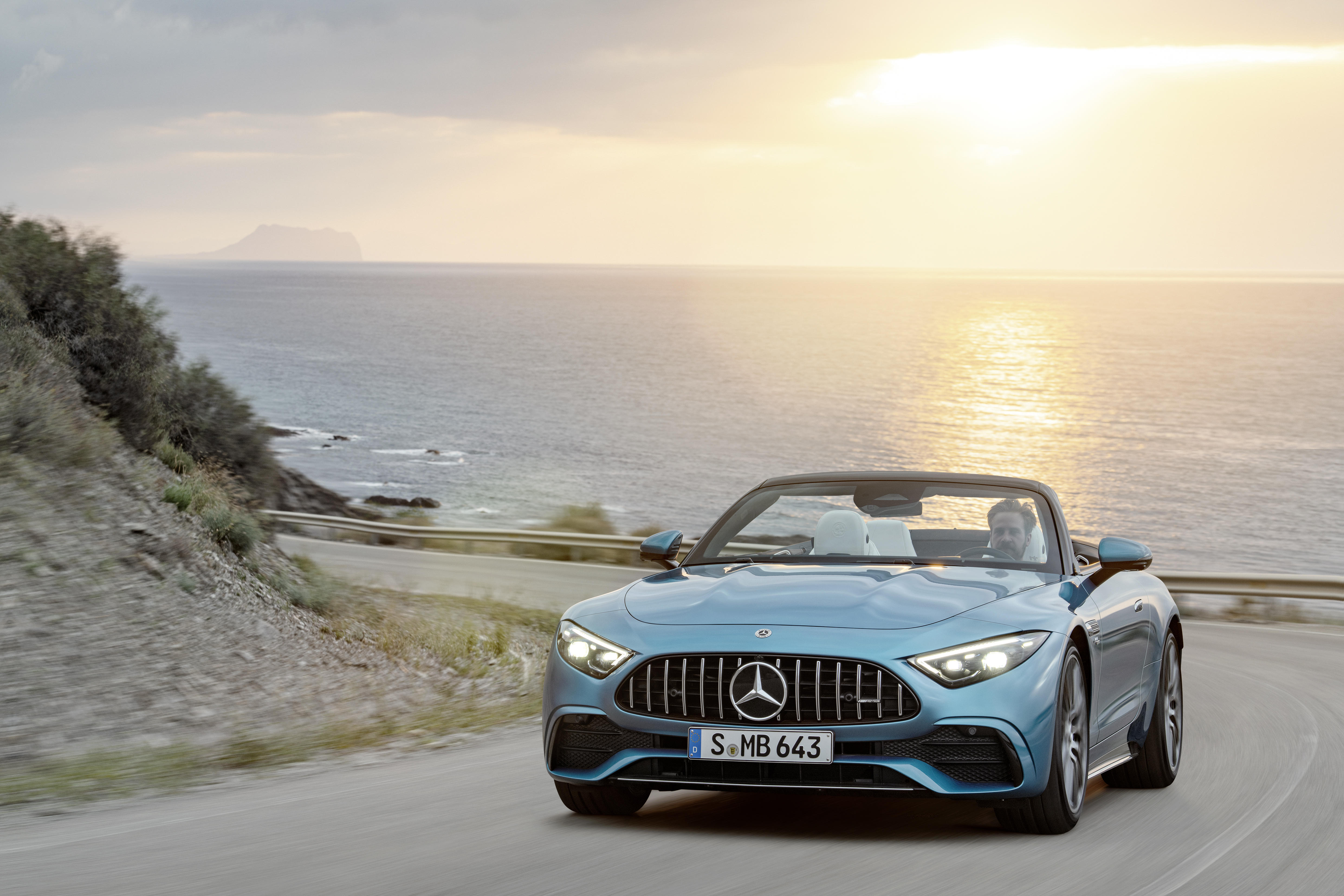
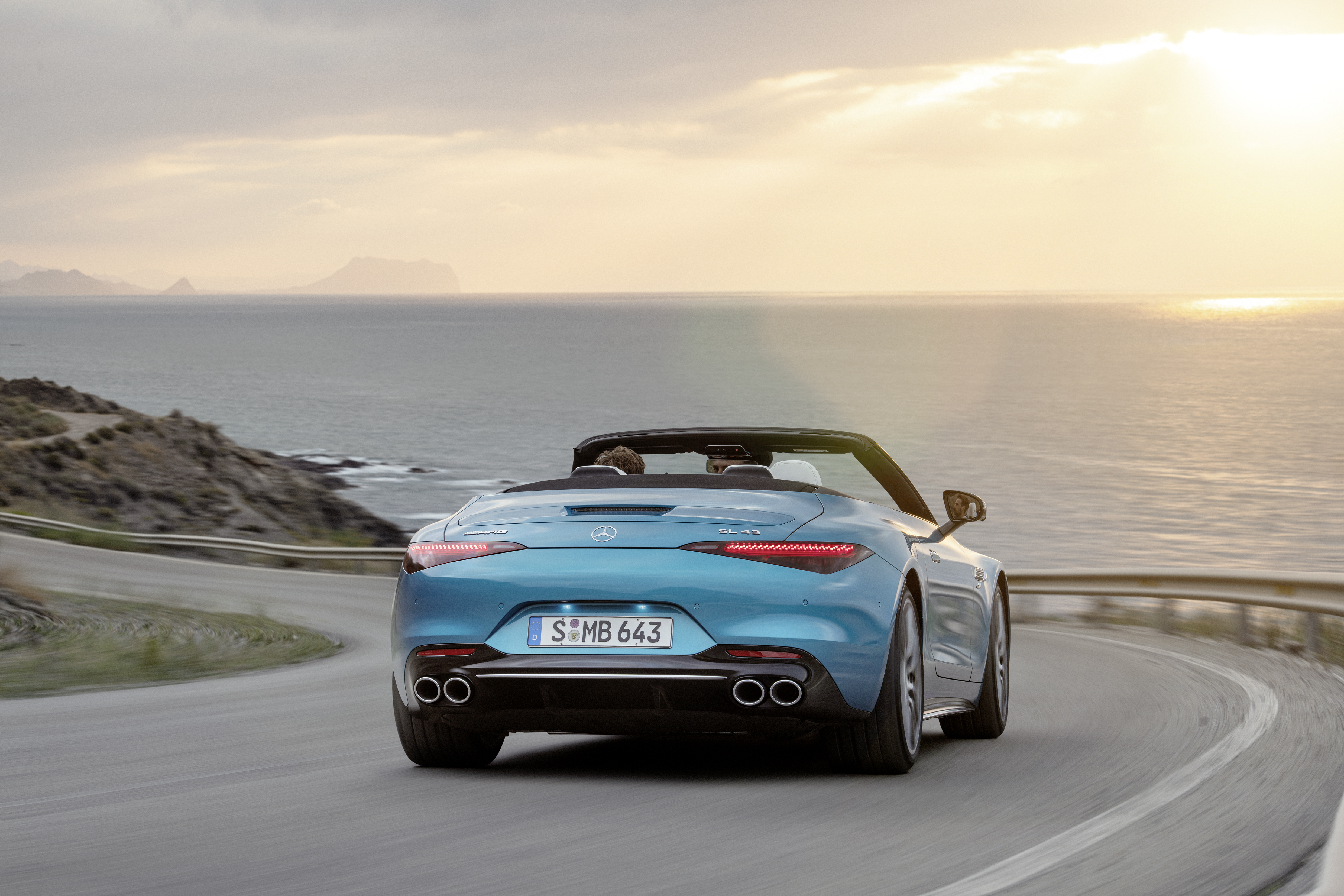
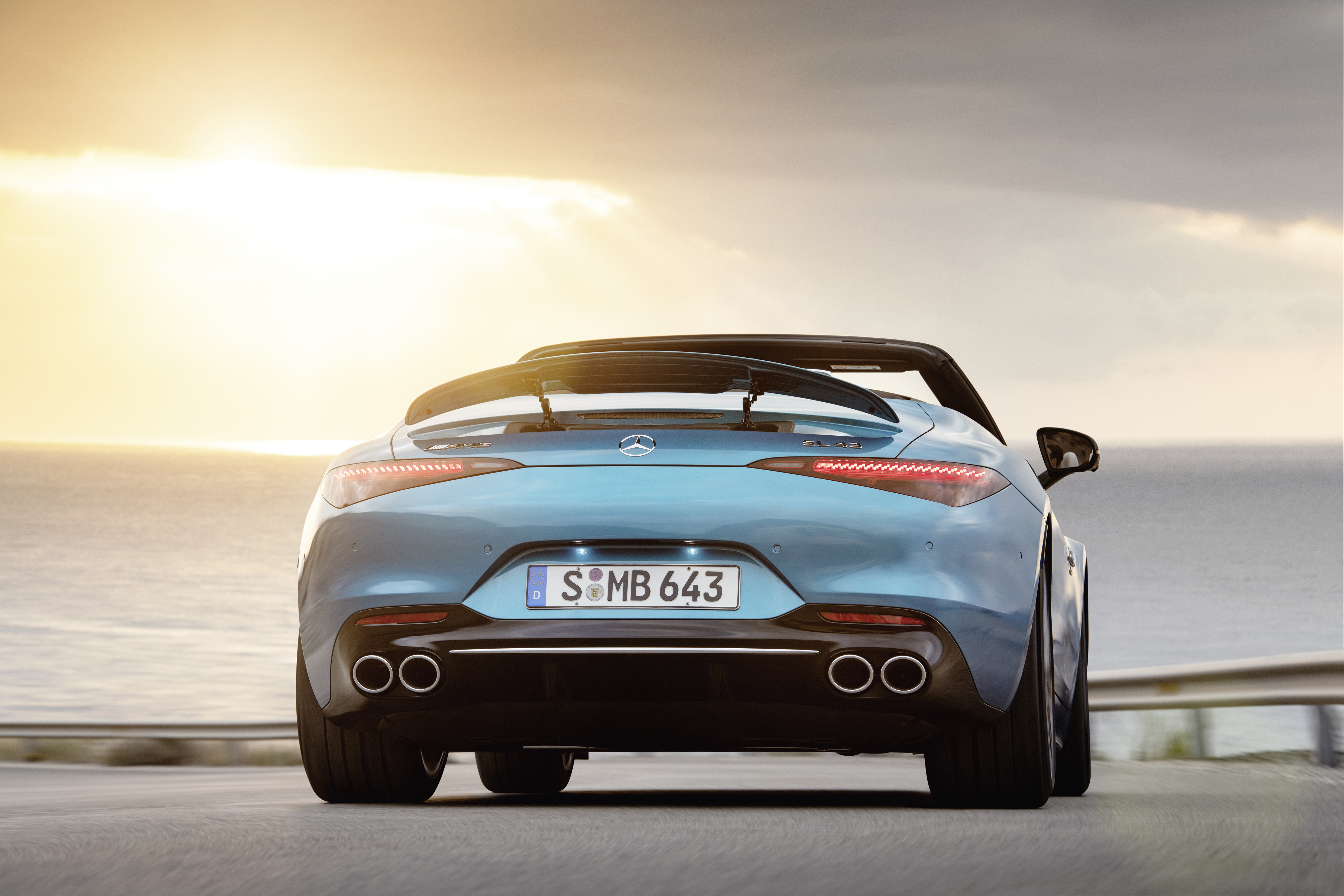



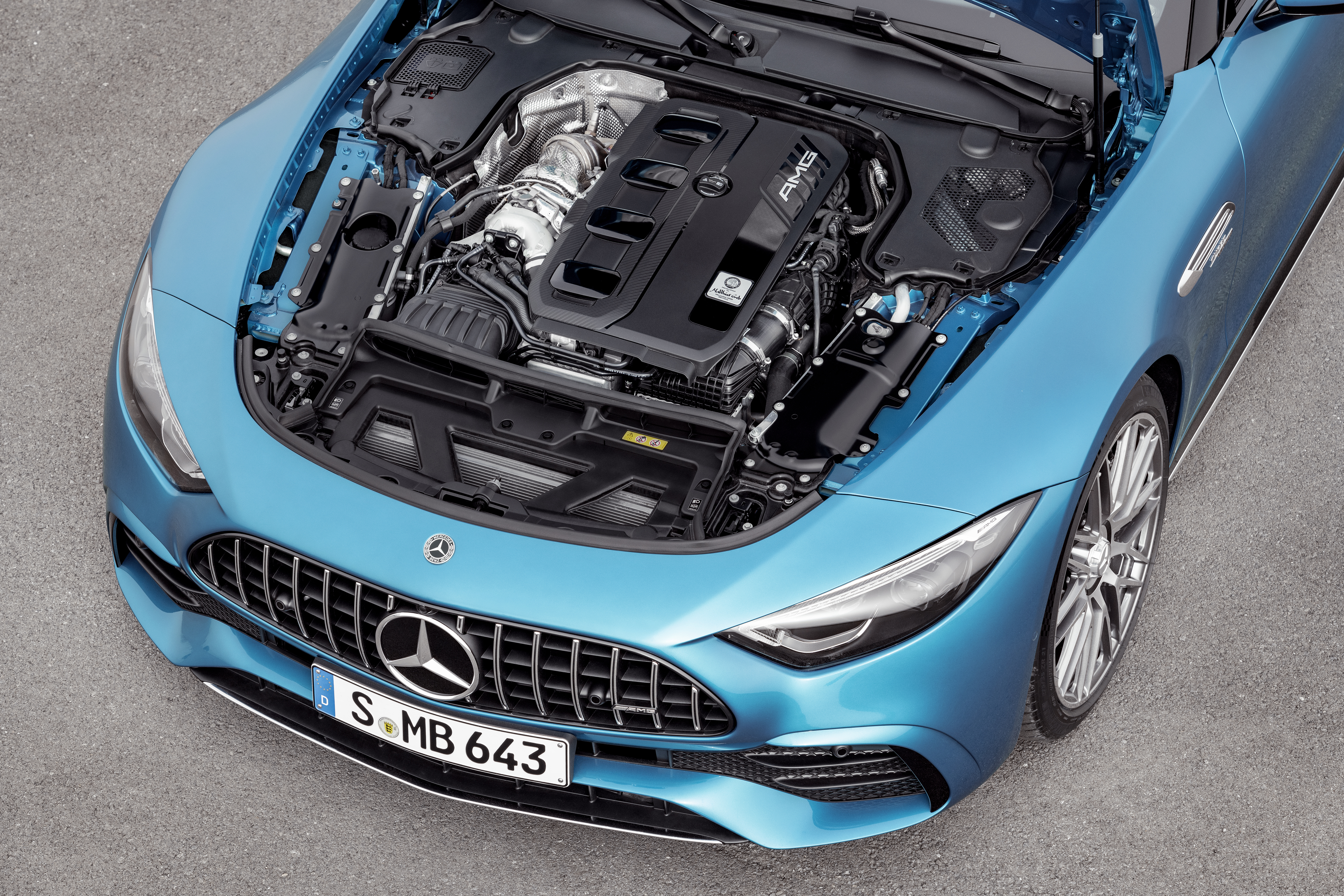

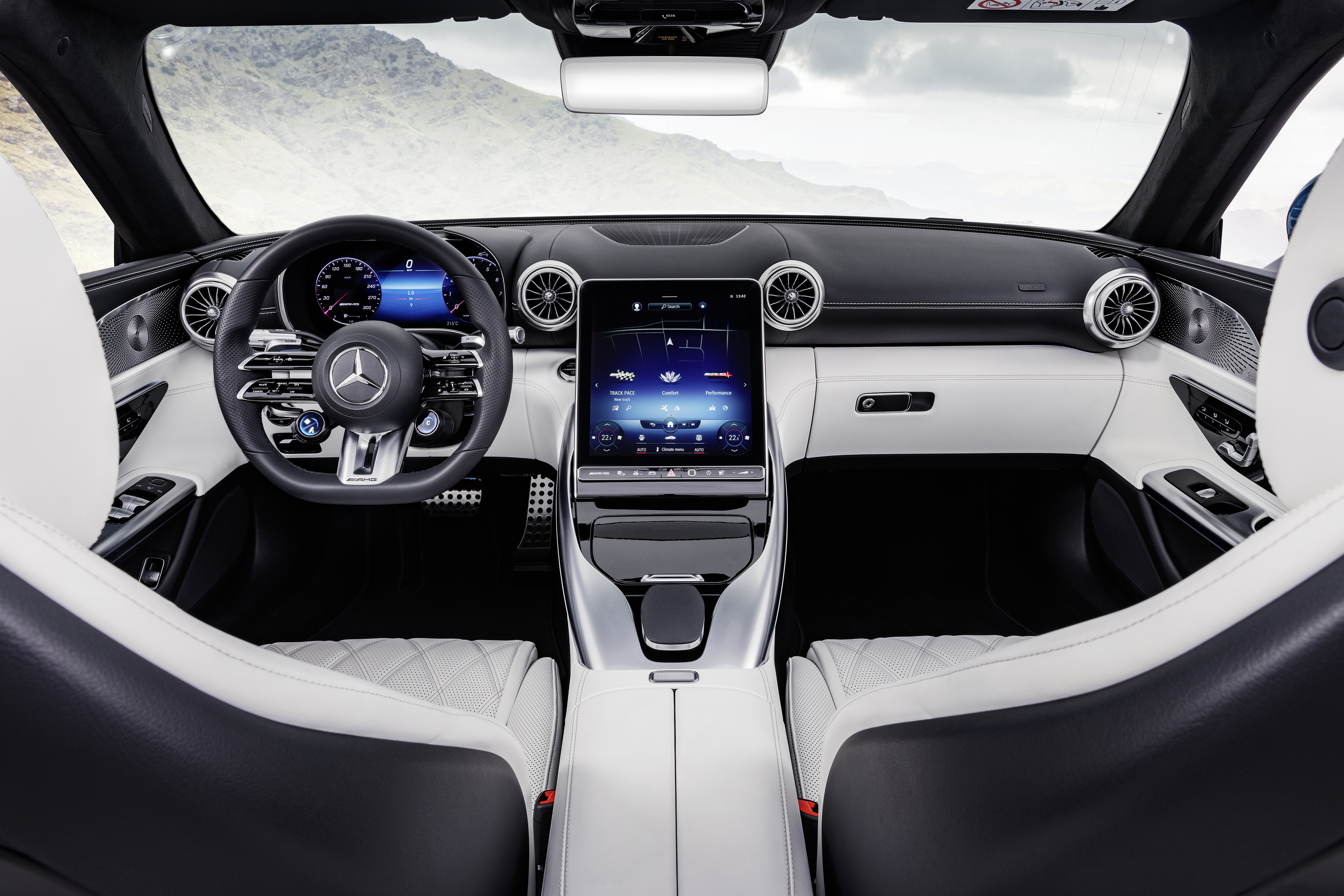
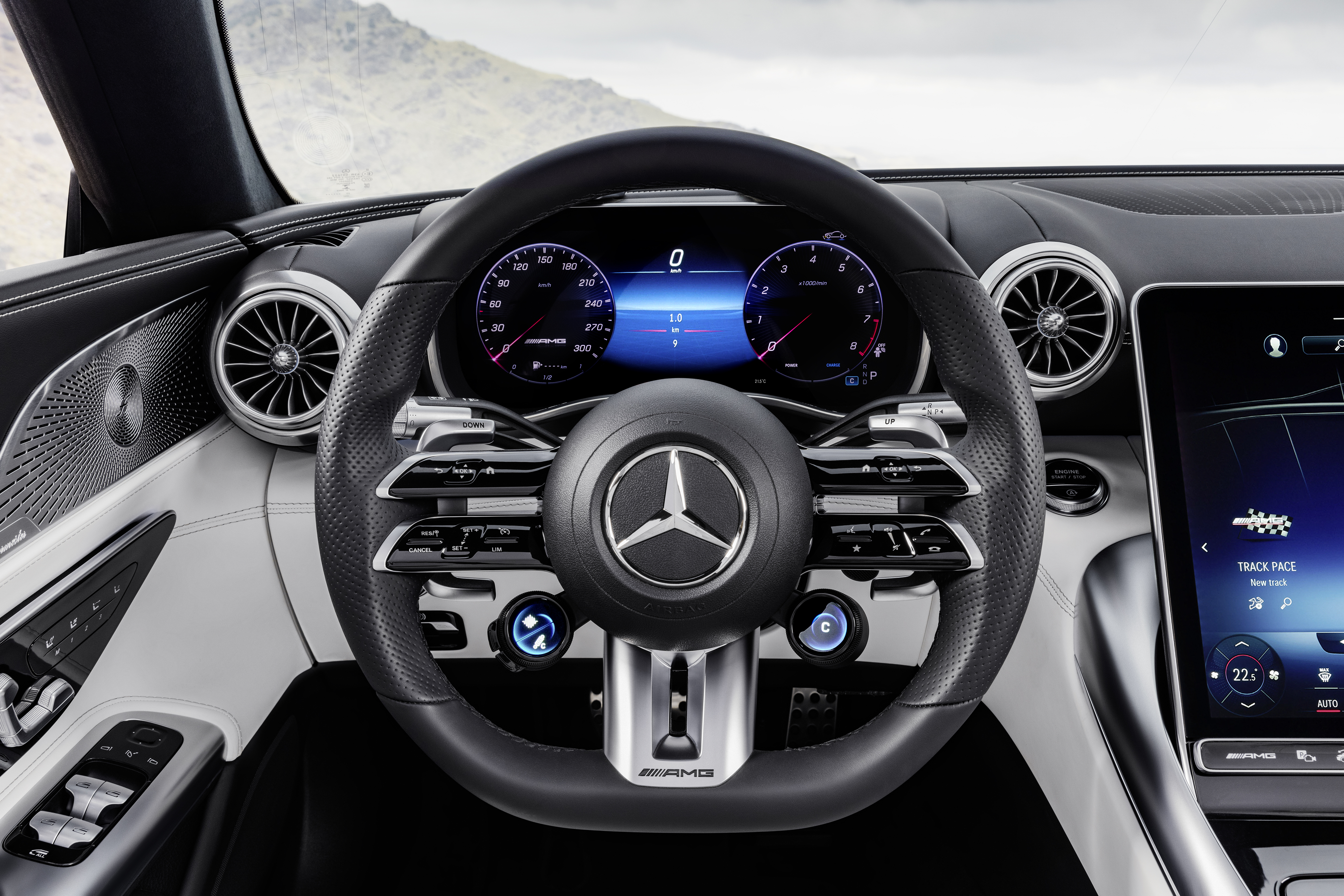

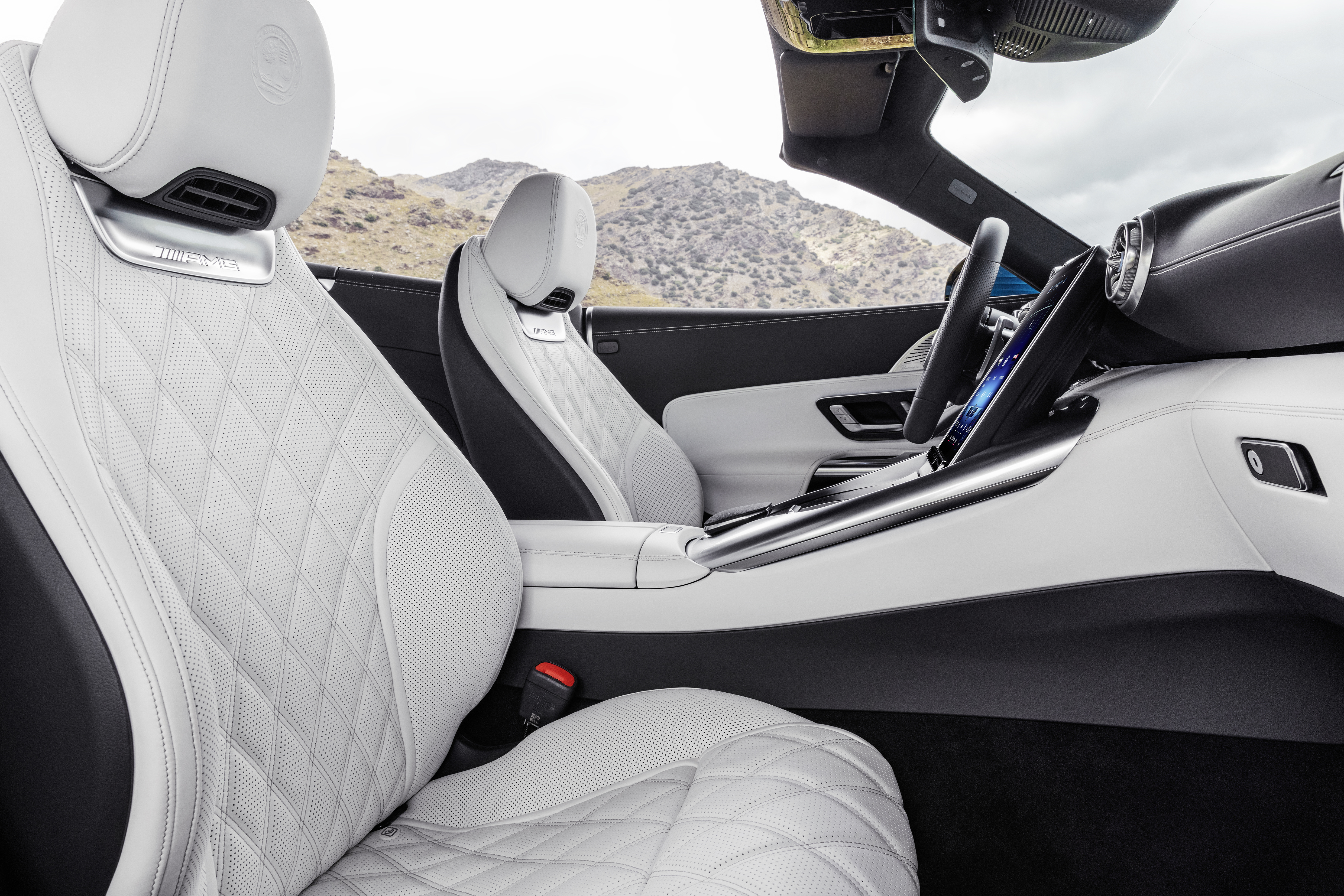








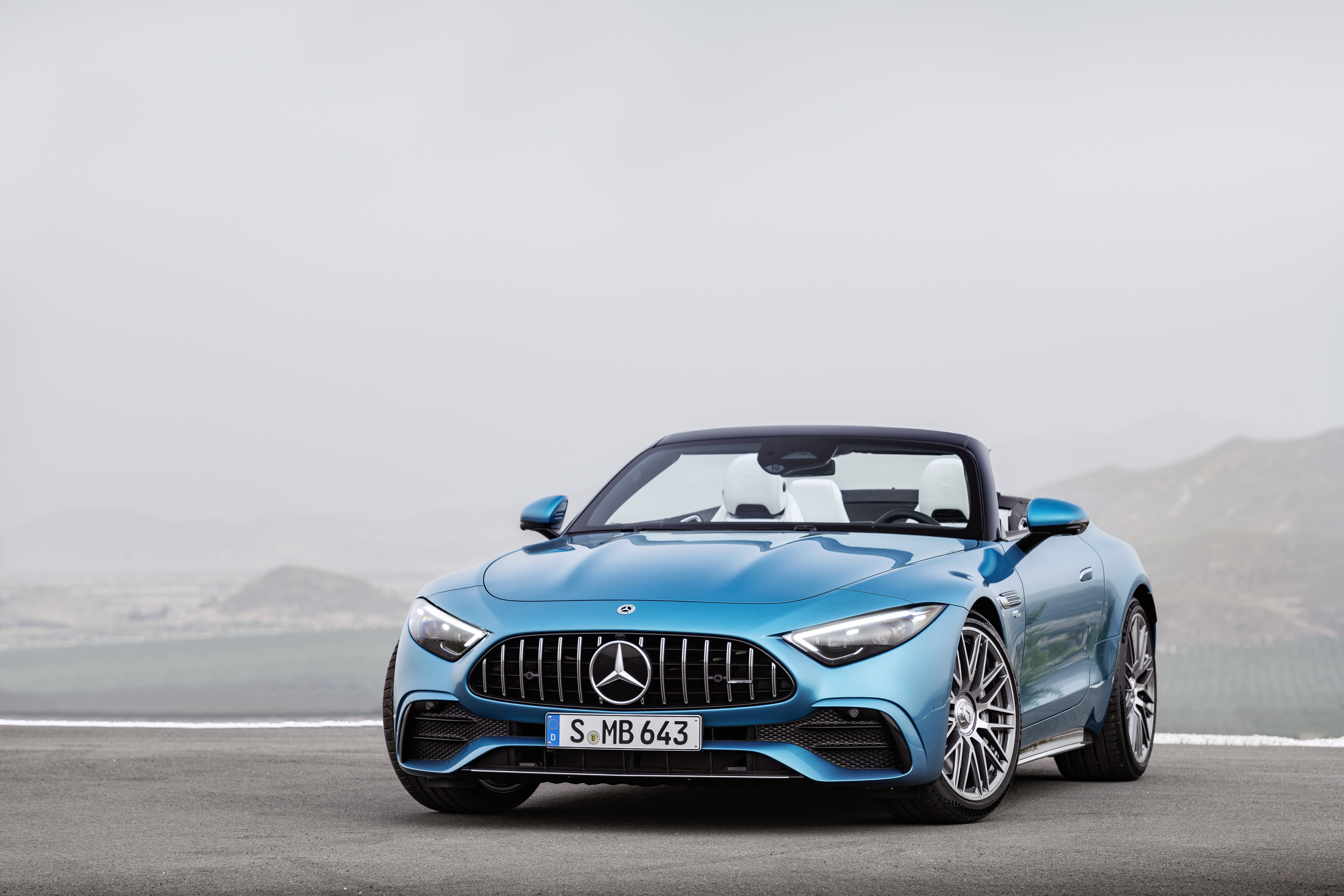

















AMG가 4기통 엔진을 장착한 SL 43을 공개했네요. 53과 63의 8기통에 비하면 무게감이 떨어지는걸 부정할 수 없지만 최신 F1 터보 기술을 탑재해 성능을 크게 훼손하지는 않았습니다. 최고출력 381마력을 내고 제로백 4.9초의 성능을 냅니다. 이정도만 되어도 충분히 스포티한 드라이빙을 즐길 수 있죠.
파워트레인만 다를 뿐, 형님들이 가진 혜택을 거의 모두 누릴 수 있는 것도 장점이죠. 가격이 어느정도일지는 모르겠지만 매력은 충분하다고 생각합니다.
자세한 건 아래 더보기를 참고해주세요
Electric exhaust gas turbocharger derived directly from Formula 1™ for the first time in a production vehicle
Affalterbach. Following the two variants with V8 engines, Mercedes-AMG presents the SL 43 (combined fuel consumption 9.4-8.9 l/100 km, combined CO2 emissions 214-201 g/km),[1] a technically innovative entry-level model of the newly developed roadster icon. Under the bonnet of the open-top 2+2-seater with fabric soft top is an in-line four-cylinder petrol engine with two litres displacement that provides the befitting propulsion. This is the first time in the world that an electric exhaust gas turbocharger is being used in a production vehicle. This technology comes from Formula 1™. The system in the SL 43 is a direct derivative of the development successfully used by the Mercedes-AMG Petronas F1 Team for many years in the premier class of motorsport. The new form of turbocharging guarantees particularly spontaneous throttle response across the entire rev range, thereby offering an even more dynamic driving experience while increasing efficiency at the same time. The turbocharger is operated via the 48-volt electrical system, which also feeds the belt-driven starter-generator (RSG). As a result, the Mercedes-AMG SL 43 has an output of 280 kW (381 hp) and a maximum torque of 480 Nm, plus an additional short-term boost of 10 kW (14 hp) from the RSG in certain driving situations. The new entry-level model in the SL family also shines with extensive standard equipment. In addition, numerous options that enhance comfort and safety offer a wide range of possibilities for individualisation.
In the 70 years of its development history, the SL experienced the transformation from a thoroughbred racing car to an open-top luxury sports car - and has long enjoyed legend status, not least for this reason. The new Mercedes-AMG SL now marks another milestone in the model's history. It combines the distinct sportiness of the original SL with the unique luxury and technological excellence of the modern Mercedes-AMG models. As the new entry-level model in the series, the SL 43 is a particularly good example of this. It is the world's first series-produced vehicle to feature an electric exhaust gas turbocharger. This technology comes directly from Formula 1™ and solves the trade-off between a small, fast responding supercharger that nevertheless achieves comparatively low peak power and a large supercharger with high peak power that only responds delayed. With its innovative engine concept, the new entry-level model of the 2+2-seater roadster is aimed more at particularly tech-savvy buyers. With its combination of a comparatively light four-cylinder engine on the front axle and rear-wheel drive, the SL 43 also displays distinctly discrete handling characteristics.
"In its long history, the SL has repeatedly set technological milestones. For example, while the legendary 300 SL Gullwing in 1954 was the world's first series-produced passenger car with direct petrol injection, the new Mercedes-AMG SL 43 is now the very first series-produced vehicle with an electric exhaust gas turbocharger. With this technology, the SL also has an outstanding performance range in its entry-level version. This means that our seemingly smallest SL combines the typical AMG Driving Performance with luxury and comfort at the absolute top level. What's more, with this innovative engine we are undoubtedly also appealing to a wider clientèle", says Philipp Schiemer, Chairman of the Board of Management of Mercedes‑AMG GmbH.
"The electric exhaust gas turbocharger is a fascinating example of the extensive transfer between Formula 1 technology and the development of production vehicles. In implementing this in conjunction with our powerful M139 four-cylinder, we were also able to draw on the enormous wealth of experience of our colleagues at Mercedes-AMG High Performance Powertrains. The technology increases agility and thus driving fun, while at the same time improving the efficiency of the drive system. We are pursuing ambitious goals with a view to our electrified future. Innovative components such as the electric exhaust gas turbocharger help us to achieve this", says Jochen Hermann, Chief Technical Officer of Mercedes‑AMG GmbH.
Electric exhaust gas turbocharger improves engine responsiveness
The operating principle of the electric exhaust gas turbocharger is based on the same technology used by the Mercedes-AMG Petronas F1 Team. An electric motor around four centimetres thin is integrated directly on the turbocharger shaft between the turbine wheel on the exhaust side and the compressor wheel on the intake side. Electronically controlled, this drives the shaft of the turbocharger directly and thus accelerates the compressor wheel before the exhaust gas stream starts to drive it conventionally.
This significantly improves immediate response from idle speed and across the entire engine speed range. The combustion engine responds even more spontaneously to accelerator pedal input, while the overall driving experience is more dynamic. In addition, the electrification of the turbocharger enables higher torque at low revs. This also increases agility and optimises acceleration from a standstill. Even when the driver takes their foot off the accelerator or applies the brakes, the technology of the electric turbocharger is able to maintain the boost pressure at all times. This ensures so that a continuous immediate response.
The turbocharger, which is operated via the 48-volt on-board electrical system, works at speeds of up to 170,000 rpm, which enables a very high airflow rate. The turbocharger, electric motor and power electronics are connected to the combustion engine's cooling circuit to create an optimal temperature environment at all times. In combination with the internally named M139 two-litre, in-line four-cylinder engine, the innovative technology in the SL 43 produces a rated output of 280 kW (381 hp) at 6750 rpm. The maximum torque of 480 Nm is available between 3250 rpm and 5000 rpm. Depending on the situation, the system also guarantees an additional boost of 10 kW (14 hp) for a short time from the belt-driven starter generator (RSG).
The second-generation RSG also functions as a mild hybrid in the 48-volt on-board electrical system, which in addition to the temporary power boost enables functions such as gliding mode and energy recovery for maximum efficiency. At the same time, the 48-volt technology also increases comfort, as the transitions between the start-stop function and the gliding mode function are almost imperceptible.
AMG SPEEDSHIFT MCT 9G transmission with wet start-off clutch and rear-wheel drive
The four-cylinder engine known as the M139, which has long been used transversely in Mercedes‑AMG compact models without an electric exhaust turbocharger, is positioned longitudinally in the SL 43. In the entry-level model in the SL series, which always features rear-wheel drive, it is also combined with the AMG SPEEDSHIFT MCT 9G transmission (MCT = Multi-Clutch Transmission) for the first time. A wet start-off clutch replaces the torque converter. It reduces weight and, thanks to its lower inertia, optimises response to accelerator pedal input, especially during spurts and load changes. The elaborately calibrated software ensures extremely short shift times as well as fast multiple downshifts if required. In addition, the intermediate throttle function in the "Sport" and "Sport+" driving modes delivers a particularly emotionally appealing gearshift experience. There is also the RACE START function, which ensures optimal acceleration from a standstill.
The driving performance is up to par: from a standstill, the SL 43 accelerates to 100 km/h in just 4.9 seconds if required, and the top speed is 275 km/h. In addition to the performance it offers, the entry-level model of the series is also distinguished by comparatively low consumption and emission figures.
Roadster architecture with aluminium composite structure for typical AMG Driving Performance
The new SL of the R232 series is based on a completely new vehicle architecture developed by Mercedes‑AMG. The new dimensional concept allows a 2+2 seating configuration for the first time since 1989 (Mercedes SL model series R129). This makes the new SL even more versatile. The rear seats increase daily practicality and offer space for people up to 1.50 metres tall (up to 1.35 metres with a child seat). If the extra seating is not needed, an insertable draft stop behind the rear seats can protect front-seat occupants from draughts on the back of their necks. Or the second row of seats can be used as additional stowage space and accommodate a golf bag, for example.
Constructed from lightweight aluminium composite, the chassis consists of an aluminium space frame with a self-supporting structure. The design guarantees maximum rigidity and is thus the perfect basis for precise driving dynamics, high comfort, optimal packaging and sporty body proportions. The aim of the body shell architecture is to realise the typical AMG Driving Performance with a focus on lateral and longitudinal dynamics, while at the same time meeting the high standards on comfort and safety.
In the new SL, the intelligent material mix enables the highest possible rigidity at a low weight. The materials used include aluminium, magnesium, fibre composites and steel, from which the windscreen frame is made, for example. This serves as roll-over protection in conjunction with the roll bar system behind the rear seats, which pops up at lightning speed when needed.
Compared to the previous model series, the torsional rigidity of the body shell structure was increased by 18 percent. The transverse rigidity is 50 percent higher than the already outstanding value of the AMG GT Roadster. The longitudinal rigidity is 40 percent higher. The weight of the body shell per se is only around 270 kilograms. Together with the low centre of gravity, the systematic lightweight construction ensures optimal driving dynamics.
Entry-level model with subtle distinguishing features in the exterior design
The exterior design of the SL 43 differs in individual details from the two eight-cylinder models. For example, it has differentiated front and rear aprons as well as round instead of angular double tailpipe trim. The defining features of the SL body design include the long wheelbase, the short overhangs, the long bonnet, the passenger compartment set further back with steeply raked windscreen, and the powerful rear end. This results in the typical SL proportions. They give the roadster its powerful, dynamic appearance - together with the voluminously modelled wheel arches and the large light-alloy wheels that are flush with the outer skin. The SL 43 runs on 19-inch light-alloy wheels as standard. In addition, the same range as for the eight-cylinder models is available as an option: aerodynamically optimised light-alloy wheels with diameters of 20 or 21 inches, which reduce air resistance through low turbulence. Particularly sophisticated are 20-inch wheels with plastic aero rings that save additional weight.
Active aerodynamics to increase dynamics and efficiency
A technical highlight for improving aerodynamics is the AIRPANEL active air control system. The horizontal louvres behind the upper air intake are electronically controlled and can be opened and closed with actuator motors. In this way, the airflow is directed according to demand, thus improving aerodynamic performance.
Normally the louvres are closed - even at top speed. This position reduces air resistance. Only once predefined components have reached certain temperatures and the demand for cooling air is particularly high do the louvres open and allow the maximum amount of cooling air to flow to the heat exchangers. This calls for highly intelligent and fast control.
The same applies to another active component of the aerodynamics: the retractable rear spoiler seamlessly integrated into the vehicle profile. It changes its position depending on the driving status. In doing so, the control software takes into account numerous parameters: It factors the driving speed, the longitudinal and lateral acceleration and the steering speed into the calculation. The spoiler assumes five different angle settings from 80 km/h to either optimise the handling stability or reduce drag.
The optional Aerodynamics Package for the Mercedes-AMG SL 43 includes larger flics on the front and rear bumpers and a larger rear diffuser. This improves both downforce and aerodynamic drag even further. The modified speed thresholds of the rear spoiler and its steeper angle of attack of 26.5 degrees (instead of 22 degrees) in the Dynamic position also contribute to this.
Fabric soft top for less weight and lower centre of gravity
The sportier positioning of the new SL also suggested the decision for an electric soft top instead of the previous metal vario-roof. The 21-kilogram reduction in weight and the resulting lower centre of gravity have a positive effect on driving dynamics and handling. The Z-fold saves space and weight, and makes it possible to dispense with a conventional soft-top compartment cover. The front header bow ensures that the open soft top is flush in its final position. At the same time, the developers were faced with the task of maintaining the high suitability for everyday use and the exemplary quiet-running. The three-layer design consists of a tightly stretched outer shell, a precisely finished roof liner and an acoustic mat made of high-quality 450 g/m² PES fleece inserted in between.
Opening and closing takes only about 15 seconds and is possible up to a speed of 60 km/h. The soft top is operated using the switch panel in the centre console or the multimedia touch screen, on which an animation shows how the process is progressing.
Interior with "hyperanalogue" cockpit and standard luxury seats
The interior of the Mercedes-AMG SL 43 also features an exciting combination of analogue geometry and the digital world - known as "hyperanalogue". This is exemplified by the fully digital instrument cluster, which is integrated into a three-dimensional visor. The standard MBUX infotainment system offers a choice of several specific display styles and different modes. The symmetrical instrument panel is designed as a powerful wing and structured into an upper and lower section. The highlight are the four galvanised turbine nozzles. Their surfaces merge into the instrument panel in the form of powerful power domes. The lower section of the instrument panel evolves fluidly from the centre console, seamlessly connecting the two elements.
Despite symmetry, the cockpit design creates a clear focus on the driver: The high-resolution 12.3-inch LCD screen of the instrument cluster is not designed to be free-standing, but integrated into a high-tech visor that prevents reflections caused by sunlight. In order to avoid disturbing light reflections caused by different sun positions when the soft top is open, the tilt of the touch screen on the centre console can also be electrically adjusted from 12 degrees to 32 degrees.
The latest generation MBUX (Mercedes-Benz User Experience) is intuitive to operate and capable of learning. It offers a host of functional content and the operating structure of the second-generation MBUX system, which debuted in the new Mercedes-Benz S-Class. In the SL, extensive AMG-specific content in five display styles is added. Exclusive menu items such as "AMG Performance" or "AMG TRACK PACE" also emphasise the sporty character.
The SL 43 is equipped as standard with a wide range of electrically and manually adjustable luxury seats in a combination of ARTICO man-made leather and fabric. Seat covers in leather, NAPPA leather and NAPPA AMG leather are optionally available, as are AMG sports seats and AMG Performance seats with their sculptural design. The optionally available upholstery in MANUFAKTUR macchiato beige/titanium grey or in MANUFAKTUR truffle brown/black ensures a particularly exclusive touch. The AMG Performance seats can also be upholstered in a combination of nappa leather and DINAMICA microfibre with yellow or red decorative topstitching.
In addition to the standard high-gloss black, the trim elements and centre console are also available in aluminium or carbon and in MANUFAKTUR chrome black. The AMG Performance steering wheel with optional steering wheel heater is available in nappa leather and nappa leather/MICROCUT microfibre.
Newly developed chassis with multi-link front axle and innovative lightweight construction measures
As standard, the SL 43 is equipped with a newly developed AMG RIDE CONTROL steel suspension with particularly powerful aluminium shock absorbers and lightweight coil springs. The new SL is the first production vehicle ever from Mercedes-AMG to feature a multi-link front axle with five links arranged entirely within the rim. This significantly improves the kinematics. At the rear axle, a 5-link design likewise controls the wheels.
To reduce unsprung masses, all suspension links, steering knuckles and wheel carriers on the front and rear axles of the new SL are made of forged aluminium. The multi-link concept controls each wheel with the least amount of elastic movement. The high camber and track stability not only enables high cornering speeds, it also provides the driver with optimal road contact at the high cornering limit. This is reflected in excellent lateral dynamics and driving stability at high speeds as well as in the good-natured reaction to external influences such as crosswinds, bumps or jumps in friction coefficients.
The lightweight coil springs are a new development: special tempering allowed their weight to be lowered without reducing their performance. In the manufacturing process, the spring pad is glued onto the spring for the first time. This firm connection prevents wear and tear caused by dirt such as sand over the course of a vehicle's life. The spring does not corrode over the life cycle, and the maximum component load can consequently be increased at less weight. This saves around 0.2 kilograms per spring.
Another lightweight construction measure concerns the torsion bar stabilisers on the front and rear axles of the SL 43. Thanks to a variable wall thickness, their weight can be reduced. The maximum wall thickness is now only used where it is required due to the maximum load, in this case in the area of the rubber mounts.
The latest generation of AMG adaptive adjustable damping is available as an option for the SL 43. The suspension control unit uses data analysis - including acceleration and wheel travel sensors - to adjust the damping force for each wheel in a few milliseconds to suit the situation. The driver can pre-select the basic set-up via the AMG DYNAMIC SELECT driving modes: at the touch of a button, the handling characteristics change, for example, from full dynamics in "Sport+" mode to smooth cruising in the "Comfort" setting. In addition, the tuning can be adjusted in three stages independently of the driving modes via a dedicated button.
AMG high-performance composite brake system for short braking distances
The newly developed AMG high-performance composite brake system guarantees excellent deceleration values and precise control. It impresses with short braking distances, sensitive response and last but not least with high stability and durability - even under extreme stress. Comfort functions include Hill Start Assist as well as pre-filling and dry braking in wet conditions. When the ignition is switched off and the vehicle is stationary, the parking position "P" is also activated. When starting off, the electric parking brake is released automatically.
The composite brake discs are particularly light: Driving dynamics and turn-in behaviour benefit from the reduced unsprung masses. Brake disc (made of cast steel) and brake disc pot (made of aluminium) are now connected with special pins. This design saves space, which is used for even better brake cooling. The directional perforation is also new: In addition to the weight saving and better heat dissipation, this solution scores points with a faster response in wet conditions as well as better pad cleaning after braking.
Optional rear-axle steering combines agility and stability
The Mercedes-AMG SL 43 can be equipped with active rear-axle steering (HAL) as an option. Depending on the speed, the rear wheels steer either in the opposite direction (up to 100 km/h) or in the same direction (faster than 100 km/h) as the front wheels. The system thus enables both agile and stable driving characteristics. The front-wheel steering ratio is more direct, making it easier to steer the vehicle at the limit with less steering effort.
Six driving modes and AMG DYNAMICS: from comfortable to dynamic
The five AMG DYNAMIC SELECT driving modes "Slippery", "Comfort", "Sport", "Sport +" and "Individual", as well as the "RACE" mode included in the optional AMG DYNAMIC PLUS Package, enable a wide spread of vehicle characteristics from comfortable to dynamic. The distinct driving modes offer an individual driving experience, precisely tailored to different driving conditions. As a feature of the AMG DYNAMIC SELECT driving modes, the SL models also feature AMG DYNAMICS. This integrated vehicle dynamics control expands the stabilising functions of ESP® with interventions that enhance agility in the steering characteristic and in ESP® additional functions. When cornering at speed, for example, brief braking intervention at the inner rear wheel generates a defined yawing moment around the vertical axis for responsive and precise turn-in.
SL equipment programme: great variety for an individual look
With the details of its extensive standard equipment as well as many additional options available, the Mercedes-AMG SL 43 offers a broad individualisation spectrum for a wide range of customer wishes - from sporty and dynamic to luxuriously elegant. This includes twelve paint finishes including the two exclusive SL colours hyper blue metallic and MANUFAKTUR monza grey magno, three roof colour variants and several new wheel designs.
Three exterior design packages are available to sharpen the look further and make it more elegant or more dynamic.
- The AMG Exterior Chrome Package contains elegant high-gloss chrome accents on the front apron, the side sill trim and the rear.
- In the AMG Night Package, selected exterior elements are finished in high-gloss black, such as the front splitter, the side sill trims, the mirror caps and the trim element in the rear diffuser. Added to this are darkened tailpipe trims. Depending on the chosen paint finish, this results in striking contrasts or flowing transitions.
- The AMG Night Package II includes additional elements in high-gloss black, including radiator grille, typography and Mercedes star at the rear.
- With the AMG Exterior Carbon Package, lightweight components made of carbon fibre evoke the SL's motorsport history. The carbon parts include the front splitter and the flics in the front bumper as well as the trim strip in the side member trim. Furthermore, there are tailpipe trims in high-gloss black and the trim strip in the diffuser in carbon or high-gloss black.
AMG DYNAMIC PLUS Package for maximum driving pleasure
The AMG DYNAMIC PLUS Package, which combines numerous high-performance components, is optionally available for the SL 43:
- Dynamic AMG engine mounts connect the engine more rigidly or more flexibly to the body, depending on the driving situation. In every driving situation, this results in the best possible balance between driving dynamics and comfort.
- The electronically controlled AMG limited-slip rear differential distributes the required power to the wheels even more promptly and precisely during dynamic cornering and rapid acceleration, thus guaranteeing maximum traction.
- The "RACE" driving mode delivers race track performance at the touch of a button with even more spontaneous engine response and a more direct accelerator pedal characteristic. Selectable as an additional driving mode via the AMG steering wheel buttons.
- The lowering by ten millimetres lowers the vehicle's centre of gravity and additionally stabilises the vehicle.
- The yellow-painted AMG brake callipers visually underline the increased driving dynamics potential.
Driving assistance systems and MBUX: intelligent helpers in the background
With the aid of numerous sensors, cameras and radar, the driving assistance systems, some of which are optional, monitor the traffic and surroundings of the new SL 43. If necessary, the intelligent helpers can intervene at lightning speed. As in the current generations of the Mercedes C-Class and S-Class, the driver is supported by several new and enhanced systems. This is done in everyday situations, for example, by helping with speed adaptation, distance control, steering and lane changes. This makes it easier to react to impending collisions. The functioning of the systems is visualised by a new display concept in the instrument cluster.
The new assistance display in the instrument cluster shows comprehensibly and transparently how the driving assistance systems work in a full-screen view. The driver can see their car, lanes, lane markings and other road users such as cars, trucks and two-wheelers in an abstracted 3D way there. The system status and operation of the assistants are visualised in this depiction of the surroundings. The new, animated assistance display is based on a 3D scene generated in real time. This dynamic, high-quality representation makes the operation of the driving assistance systems transparent as an augmented reality driving experience.
Numerous connectivity services available
The MBUX (Mercedes-Benz User Experience) infotainment system enables extensive operating options and many digital services from Mercedes me connect. The strengths include the intuitive operating concept via touch screen or touch control buttons on the steering wheel, Smartphone Integration of Apple CarPlay and Android Auto as well as hands-free operation via Bluetooth connection and Digital Radio (DAB and DAB+). In conjunction with MBUX, customers already have access to connectivity services such as Live Traffic Information. Mercedes me connect makes the new SL altogether more intelligent: Additional functions can be used before and after the journey or while on the road. All that is required is to link the roadster to a Mercedes me account in the Mercedes me Portal and accept the Terms of Use. Thanks to navigation with Live Traffic Information and Car-to-X communication, the customer drives with real-time traffic data. This way, traffic jams can be avoided efficiently and valuable time can be saved. Networked vehicles exchange information about traffic events by means of car-to-x communication.
Technical data[1]
Mercedes-AMG SL 43
| Engine | |||
| Number of cylinders/arrangement | 4/in-line | ||
| Displacement | cc | 1991 | |
| Rated output | kW/hp | 280/381 | |
| at engine speed | rpm | 6750 | |
| Additional output (Boost) | kW/hp | 10/14 | |
| Rated torque | Nm | 480 | |
| at engine speed | rpm | 3250-5000 | |
| Compression ratio | 10.0 | ||
| Mixture formation | combined direct petrol injection and intake manifold injection, turbocharging by means of electrically assisted exhaust gas turbocharger | ||
| Power transmission | |||
| Drive system layout | Rear-wheel drive | ||
| Transmission | AMG SPEEDSHIFT MCT 9G (automatic transmission with wet multi-disc start-off clutch) | ||
| Gear ratios | |||
| 1st/2nd/3rd/4th/5th/6th/7th/8th/9th gear | 5.35/3.24/2.25/1.64/1.21/1.00/0.87/0.72/0.60 | ||
| Reverse | 4.80 | ||
| Chassis | |||
| Front axle | AMG RIDE CONTROL suspension with aluminium double wishbones, anti-squat and anti-dive geometry, lightweight coil springs and stabiliser bar | ||
| Rear axle | AMG RIDE CONTROL suspension with aluminium double wishbones, anti-squat and anti-dive geometry, lightweight coil springs and stabiliser bar | ||
| Brake system | Hydraulic dual-circuit brake system; 390 mm composite brake discs at front, vented and perforated, 6-piston aluminium fixed calliper; 360 mm composite brake discs at rear, vented and perforated, 1-piston aluminium floating calliper; electric parking brake, ABS, Brake Assist, 3-stage ESP® | ||
| Steering | Electromechanical speed-sensitive power steering with rack and pinion, variable steering ratio (12.8:1 at dead centre) and variable power assistance | ||
| Wheels | front: 9.5 J x 19; rear: 11 J x 19 | ||
| Tyres | front: 255/45 ZR 19; rear: 285/40 ZR 19 | ||
| Dimensions and weights | |||
| Wheelbase | mm | 2700 | |
| Front/rear track | mm | 1665/1629 | |
| Length/height/width | mm | 4705/1359/1915 | |
| Turning circle | m | 12.84 | |
| Boot capacity | l | 213-240 | |
| Kerb weight acc. to EC | kg | 1810 | |
| Payload | kg | 335 | |
| Tank capacity/of which reserve | l | 70/10 | |
| Performance, consumption, emissions | |||
| Acceleration 0-100 km/h | sec. | 4.9 | |
| Top speed | km/h | 275 (electronically limited) | |
| Combined fuel consumption, WLTP | l/100 km | 9.4-8.9 | |
| Combined CO2 emissions, WLTP | g/km | 214-201 | |
[1] The stated figures are the measured "WLTP CO₂ figures" in accordance with Article 2 No 3 Implementing Regulation (EU) 2017/1153. The fuel consumption figures were calculated on the basis of these figures.
'Mercedes-AMG' 카테고리의 다른 글
| F1 기술의 양산 로드카, 1000마력 메르세데스-AMG 원(Mercedes-AMG ONE) 사진 원본입니다 (0) | 2022.06.05 |
|---|---|
| 2022 브라부스 800 어드벤처 XLP 슈퍼화이트(BRABUS XLP Superwhite) 깨끗한 사진 원본입니다 (0) | 2022.05.10 |
| AMG 55주년 기념해 만든, 2022 메르세데스-AMG G63 "Edition 55" 패키지 고품질 사진 (0) | 2022.03.25 |
| 2023 메르세데스 AMG GT 63과 GT 63 S 4-도어 모델 사진 원본 정리합니다 (0) | 2022.03.22 |
| 독일 기준 1억 5천, 2022 메르세데스 AMG EQS53 4매틱 플러스(AMG EQS 53 4MATIC+) 사진 원본 83장 (0) | 2021.12.20 |




댓글